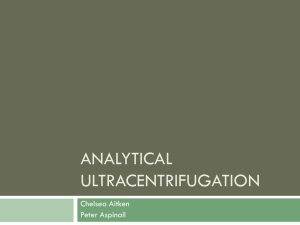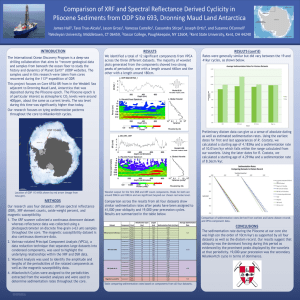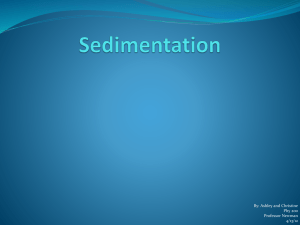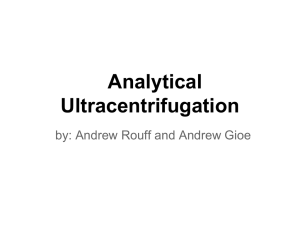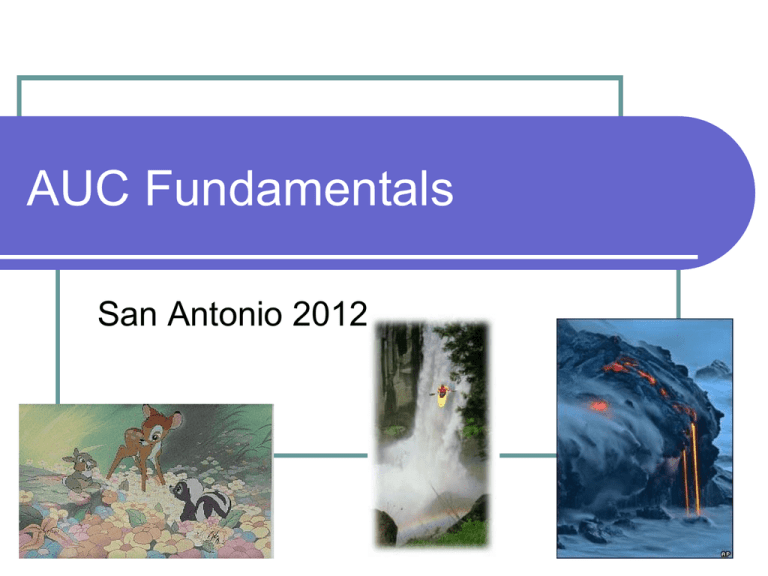
AUC Fundamentals
San Antonio 2012
1
Outline
General considerations
Sedimentation velocity
General information
Sedimentation equilibrium
General information
Practical issues
Data interpretation
2
An AUC experiment consists of…
The setup
Rotor
Cells
Windows
Method
Centerpieces
Optical systems
Compatibility with sample and
method
Sample concentration range
Temperature
Rotor speeds
Number of scans
Delay before scans
Interval between scan
Optimizing information content
Waiting
For pressure
For temperature
Always with sedimentation velocity
3
An AUC experiment consists of…
Analysis
Sedanal, Sedfit, UltraScan, Dcdt+
Velocity: Size distribution
Sedphat, Svedberg. UltraScan
Velocity: Discrete species
HeteroAnalysis, Nonlin, Sedphat,
Equilibrium: Thermodynamics Ultrascan
Interpretation
Solvent properties
Density, viscosity
pH
Ionic strength
Solute properties
Measure or calculate
Sednterp, Sednterp2, UltraScan,
Sedfit
Buoyancy factor
Signal concentration conversion
Size, asymmetry
4
What do you want to know?
Difficulty Sample
Size distribution
Stoichiometry- single component
Reaction reversibility
Stoichiometry and energetics
Easy
Less
Hard
More
Self association
Hetero association
5
General Sample Handling
Gel filter sample prior to analysis
Estimate concentration and volume
Dialyze sample: equilibrium with solvent
Unless the question being addressed is “What’s in a solution”
May be problematic with detergents
Required for interference optics, not with others
Choose centerpiece material and window
types
Interference requires sapphire windows
Sapphire good for all optical systems
Charcoal epon quite “inert” for sedimentation velocity
Kel-F for sed equilibrium (lower g-force)
6
Sample Handling
Sample Arrives
Gel filtration needed?
General Sample Handling
Estimate concentration and volume
Choose optical system
Sample dialysis?
Sedimentation Equilibrium
Short column
Quick survey
Heteroassociations
Titrations
Sedimentation Velocity
Rotor speed
Concentrations
"Long" column
Detailed analysis
Low molecular weight
Heterogeneity
7
Optical system choices
Protein
Polysaccharide
Nucleic Acid
Choice of optics Interference optics Absorbance optics
1 A230 or 280
1 A260
C > 0.1 mg/ml
1 mg/ml
5 nM fluorescein
5 nM fluorescein
5 nM fluorescein
Sensitivity
Range
Precision
Absorbance
Interference
Fluorescence
0.1 OD
2-3 logs
Good
0.05 mg/ml
3-4 logs
Excellent
100 pM fluorescein
6-8 logs
Good
Summary comparison
Absorbance
Sensitivity
0.1 OD
Radial Resolution 20-50 μm
Scan time
60 – 300 seconds
Fluorescence
Interference
100 pM fluorescein
20-50 μm
90 seconds
10-6 Δn
10 μm
1 second
(all cells)
When to Use
•
Selectivity
• Sensitivity
• Non-dialyzable
• Selectivity
•
Sensitivity
• Non-dialyzable
• Small
quantities
•
Buffer absorbs
• Sample doesn’t
• Variable ε
• Accurate C
• Short column
equilibrium
9
Sedimentation velocity
d 2c 2 1 dc 2
dc 2
2 dc 2
D 2
s
x
2
c
2
dx
dt
dx
x
dx
1.2
S
A230
0.8
0.4
D
0.0
6.0
6.4
6.8
7.2
r (cm)
10
Distance moved by s & D
Sediments ~0.25 µm in 1 s
10
0.1
Optical resolution limit
1E-3
Log10 r (cm)
For s = 5 x 10-13 s = v/a
At 60,000 rpm, 2 = 3.959x107/s2
at 6.5 cm 2r = 2.57x108 cm/s2
v = 5x10-13*2.57x108 cm/s2
v = 2.5x10-5 cm/s or 0.25 µm/s
1E-5
1E-7
D
1E-9
For D = 5x10-7 cm2/s
<x> = (2Dt)1/2
in 1 second <x> = 1x10-3 cm
Diffuses ~10 µm in 1 s
1E-11
S
1E-13
1E-15
1E-11
1E-9
1E-7
1E-5
1E-3
0.1
10
1000
Log10t (sec)
11
Choosing a rotor speed
Component resolution improves as ω2
Need sufficient scans for analysis
What is sufficient?
20 minimum
2 hours top to bottom if possible
Avoid boundary shifting significantly
during a scan
What is significantly?
< Optical resolution
12
Selecting rpm
Velocity versus rpm
Time to move 1.5 cm
0.07
14400
Velocity cm/s
0.05
0.04
Seconds meniscu to base
5s
15 s
30 s
90 s
270 s
810 s
2430 s
0.06
0.03
0.02
10800
Time at 5 s
Time at 15 s
Time at 30 s
Time at 90 s
Time at 270 s
Time at 810 s
Time at 2430 s
2 hours
7200
3600
0.01
0
0.00
0
10000
20000
30000
40000
50000
60000
0
10000
20000
30000
40000
50000
60000
Rpm
Rpm
Optical resolution
13
Time needed to move 100 μm
Sets the maximum resolution in s.
14400
Seconds
10800
0.1 s
7200
5s
3600
30
270
0
0
10000
20000
30000
40000
50000
60000
Rpm
14
Sedimentation velocity
Balance of forces
v
fv
M pa
M sa
Experimental definition
Molecular definition
M s a fv M p a
M M a fv
M M v
p
s
p
s
f
M p 1 v
a
M
f
v
s
f a
b
15
QAD analysis
Just look at the data
Non-sedimenting
material?
Plateau sloped?
1.0
0.8
Multiple
boundaries?
A230
0.6
0.4
0.2
0.0
6.0
6.4
6.8
7.2
r (cm)
16
Effect of shape on S
S = Mb/f
f = 6πξRs
For a given mass, a more symmetrical shape
will sediment faster
17
Effect of shape on S and D
g(s*) Analysis of 20k-PEG-Lysozyme
2.5
Mono-20k-PEG-Lysozyme 34,000
Tri-20k-PEG-Lysozyme
72,000
Di-20k-PEG-Lysozyme
53,000
Lysozyme
14,000
g(s*)
2.0
1.5
1.0
0.5
0.0
0
0.5
1
1.5
2
2.5
3
3.5
4
4.5
s*
18
Hydrodynamic nonideality
As macromolecule sediments, solvent
must take its place
50 microns
19
Hydrodynamic nonideality
There is a concentration dependence to
hydrodynamic nonideality
Counter-flow of solvent will affect adjacent
molecules
50 microns
20
Effect of concentration on S and D
1.0
0.5
0.0
6.2
6.4
6.6
6.8
7.0
Dilute
7.2
radius (cm)
1.0
0.8
s higher
concentration
concentration
High concentration
s
0.6
0.4
0.2
s lower
0.0
6.2
c
6.4
6.6
6.8
7.0
7.2
radius (cm)
21
Extrapolate s and D to c = 0
The concentration of macromolecules affects
sedimentation and diffusion
Expressed as s(c) and D(c)
Extrapolate s and D to get standard values
so = sc 0 and Do = Dc 0
s/so
Slope = -ks
[c]
D/Do
Slope = -kD
[c]
22
Shape and concentration effects on s
6
25
C
2.0 mg/ml
1.0 mg/ml
0.5 mg/ml
0.25 mg/ml
5
4
20
D
B
3
C
s*
g(s*)
15
D
B
10
2
5
1
0
A
0
5
10
15
s*
20
25
0
0.0
A
0.5
1.0
1.5
2.0
2.5
[protein] mg/ml
23
What are f and f/fo
f = 6πηRS
For non-stick conditions f = 4πηRS
What is RS?
“The radius of the equivalent sphere.”
From the Navier-Stokes equation
fo
Conservation of mass, energy, linear and rotary momentum
NOT JUST SHAPE… e.g. primary charge effect
is an ad hoc reference state
Anhydrous sphere with of volume Mv-bar
Based on Teller radius
f/fo is mostly about molecular asymmetry
Also about charge coupling
A fitting parameter linking s to M
Empirical relationship shows that f/fo ~1.2 for spherical molecules
24
Viscosity
Newtonian
/c
v=0
F due to transfer of momentum
Useful with very large particles
Gross shape information
/c
Depends primarily on the
effective volume occupied by the
macromolecules
Non-Newtonian
v
Sphere
Rod
Axial ratio
25
Mechanics of viscosity
y
v=0
x
Deformation of liquid is shear
Shear strain dx/dy
Shear rate is dv/dy (s-1)
Shear stress F/A, force g-cm/s2/cm2
A liquid subjected to constant shear stress
will shear at a constant rate so long as the
force is maintained
26
Sedimentation velocity protocols
If you know nothing about the size distribution
Resolution of components increases as H and ω2
Fill the cells as full as possible
Run as fast as possible
Wait for T to stabilize before starting
Start the machine at 3000 rpm
Watch for sloped plateau and boundary shape
T gradient will develop during acceleration- dissipates in minutes
Run 3 concentrations spanning as wide a range as possible
Initially run at 20 oC to simplify analysis.
If interacting system is being characterized
Concentration range may need to be higher
Vary molar ratio of components
May use multiple temperatures to dissect the association energetics.
29
When to choose equilibrium
Solution average molecular weight
Stoichiometry of complexes
Association constants
Discrete assembly scheme
Characterize thermodynamic nonideality
No hydrodynamic nonideality
30
Sedimentation Equilibrium
A balance of fluxes
Js cv cs 2r
c
JD D
r
c
Js JD
At equilibrium
cs 2 r D
r
2
s
1 dc d ln c
2
D cr dr d r
2
Intuitive, but not energetically rigorous
Sedimentation Equilibrium
A balance of energies
Gravitational
potential gradient
2
r
Mbg Mb2 r Mb2d
2
dG
Chemical
RT d ln c
dc
potential gradient
2
2 r
At equilibrium
Mb d RTd ln c
2
Mb 2 d ln c
RT
2
r
d
2
32
Sedimentation Equilibrium
A thermodynamic view
d
dc 2
d ln c 2
2
2
d
r
d
dc 2
2
d RT d ln
1
dc
M
d
ln
c
2
2
2
• d/dc2 at constant chemical potential is the correct buoyancy
term
• We are counting particles in sedimentation equilibrium, not
weighing them
33
Equilibrium versus aggregate?
0.14
0.14
Monomer
Dimer
Total
0.12
0.10
Signal
0.10
Signal
Monomer
Dimer
Total
0.12
0.08
0.08
0.06
0.06
0.04
0.04
0.02
0.02
0.00
0.00
5.8
5.9
6.0
6.1
r (cm)
6.2
6.3
5.8
5.9
6.0
6.1
6.2
6.3
r (cm)
They are indistinguishable at a single loading concentration
and single rotor speed.
Must use multiple loading concentrations over wide range
(e.g. 1:1, 1:3, 1:9)
Multiple rotor speeds (covering σmonomer from ~2 to ~10)
34
Self association
Hetero-association
A hetero-associaton has multiple components
A self association has one component
and multiple species
but multiple species
cc(( rr )) ccii (( rr ))
co1e 1 com1Ka' 1 me m 1 self association of component 1
1
1
m
co 2 e 2 con2 K''a1 n e n 2 self association of component 2
n
One
component
m species
'''
( j 1 k 2 )
c c Ka1 j k e
heteroassociation
j k
o1 o 2
j, k
35
Golden rules of sedimentation
equilibrium
Examine at least 3 loading concentrations
Examine at least 3 rotor speeds
Span ~1-log range (e.g. 1:1, 1:3, 1:9 dilutions)
Cover the range of ~2 < < ~10 (monomer)
Adjust this range for associating systems.
For hetero-associating systems
Characterize each component separately
Vary mole ratio of components
Vary total concentration at each mole ratio
36
AUC Fundamentals
Practical considerations
37
Suppose you head a facility
What kind of macromolecules are we dealing with?
What is in the solvent?
How much sample do you have
What awful behavior does your molecule exhibit that
you are reluctant to tell me about?
How will you react if the sedimentation results don’t
match your working hypothesis…
Or get your hands on?
Or your delusional molecular fantasy?
What are going to do to me if it gets sucked into the
vacuum system?
38
What kind of macromolecules?
Proteins- general
What is the amino acid composition?
Is it conjugated?
Fluorescence characteristics?
Soluble? In what?
With what?
How much?
Absorbance characteristics?
Is it highly charged and small?
Globular of fibrous?
Be alert for the phrase “it loses activity if…”
Is it alone, or did it bring its buddies with it?
How is the sample purified?
Is GPC part of the purification protocol?
What tests for purity are used?
v-bar
frictional coefficient
M, v-bar
frictional coefficient
Which detector to use
density, v-bar
aggregation
Expectations
39
What kind of macromolecules?
Proteins- self association
Is it known (expected) to self associate?
Is the self association ligand-linked?
What is known about the association
stoichiometry?
What is known about the strength of association?
What is the mass/association characteristics of
the ligand?
Will the ligand interfere with any of the optical
systems?
Molecular weight &
Concentration range
Optical system
Molecular weight
Number of
components
Optical system
What questions do you want answered by
sedimentation?
E.g. reversibility of the reaction
Time scale of reversibility
Homogeneity of association
Effect of ligand on association
Strength and stoichiometry of association
Linkage energy between ligand and protein
association
40
What kind of macromolecules?
Proteins- hetero association
All of the questions above must be
asked about each component.
Each component needs to be
characterized individually
Are they known (expected) to
associate?
What is known about the association stoichiometry?
What is known about the strength of association?
Do the components self associate?
Is the association ligand-linked?
What is the mass/association characteristics of the ligand?
Will the ligand interfere with any of the optical systems?
41
What kind of macromolecules?
Polysaccharides
What is the composition?
Is it charged or neutral?
Does it have any
chromophores?
Be prepared for severe
hydrodynamic nonideality.
Characteristics are best
determined by extrapolation to
[C] 0
If charged, be prepared for severe
thermodynamic nonideality, too
Optical systems
Expectations
Expectations
42
What kind of macromolecules?
Nucleic acids
Be prepared for severe hydrodynamic
and thermodynamic nonideality.
Characteristics are best determined
by extrapolation to [C] 0
The partial specific volume of highly
charged molecules depends on the
solvent composition
Best off determining vbar if possible
Expectations
M, vbar
Expectations
43
What kind of macromolecules?
Others kinds of molecules
Nearly any system will benefit from
vbar
Expectations
characterization by sedimentation
Hetero-associations (e.g. protein-DNA)
Small molecules: drugs, ligands,
gasses
Is it monomeric?
Can approximate vbar from
composition/density
Large aggregates: viruses, organelles
Be fearless!!
44
What is in the solvent?
Compatibility with centerpiece
Does it absorb UV?
What is the solvent viscosity and
density?
BME, DTT, unreduced Triton X100
Nucleotides, flavones
Salts and neutral molecules will affect density
PEG, glycerol affect viscosity strongly
Will any of the solvent components
sediment significantly?
Will the gradients matter biochemically?
45
Centerpieces
SedVel60K
SedVel50K
Meniscus
matching
4-channel
Velocity/Equilibrium
12 mm
Synthetic
boundary
Band forming
• Inspection and polishing
3 mm
6-Channel
Equilibrium
1 mm
• Charcoal-filled Epon
• Aluminum-filled Epon
• Aluminum
• Titanium
46
Windows and holders
Window
Window cushion
Absorbance
Sapphire
Fluorescence
Fused silica
Plastic
Interference
Top
Window liner
(gasket)
Window holder
Plastic
Aluminum
Interference
Bottom
47
Cell assembly
Lube
• Screw ring
• Housing thread
• Rotor hole
• Torque to 130
• Torque slowly
• Torque 3 x
• If “chattering,” re-lube
• Re-torque after ΔT
• Use softer gasket
• Teflon, neoprene
• Hex-head screws
• Torque screwdriver
48
Cell alignment in rotor
Gabrielson J, Randolph TW, Kendrick BS and Stoner MR (2007) “Sedimentation
velocity analytical ultracentrifugation and SEDFIT/c(s): Limits of quantitation for a
monoclonal antibody system” Anal. Biochem. 361:24-30.
• < ±0.2o to prevent false peaks
• Limits of visual detection
• Rely on accuracy of centerpiece
• Scribe lines mark cell housing center
• Want cell walls radially directed
• Tool provides reproducibility
• Require accuracy
• Tool to test alignment
49
Component and cell press
Arbor presses
Designed specifically to ‘press’ out
Cells from rotors
Cell components from cell housings
50
Cell washer
Rinse, wash, rinse, dry
Press start & walk away
1-holer or 4-holer
Compatible with
< 10 minutes/channel
2 M HCl, 2 M NaOH
Hellmanex
SDS, RBS
Alcohols
Spin or Beckman 2channel cells
Spin 4-channel cells
Not flow-through cells
51
AUC Fundamentals
Data interpretation
52
Correcting for Buoyancy
MB = M (1 - vρ )
M is the anhydrous molecular weight
v is the partial specific volume
ρ is the solvent density
Approximate M (1- Sdivi
Using neutral buoyancy
Set 1-vi = 0 for a component
Useful with detergents
Determining
Depends on solvent component
concentrations
Depends on T
Estimation from buffer concentration
Adjust to T using H2O (T)
Best if only one component in high
concentration
Measurement
Pycnometry, density meter, etc.
Partial Specific Volume
Measure, but more frequently calculated
Depends on composition
Depends weakly on T
Highly charged proteins need adjusting
vT = v25 + 4.25x10-4 (T – 25)
v smaller than calculation
Depends on solvent composition
Special care needed for high C components
Worked out for 6 M Gdn and 8 M Urea
The buoyancy factor is (dρ/dc2)μ
(1-vρ) is an approximation, only valid for
q
q
a 2-component system k 0 ck k 0 vk ck 1
Gravitational field really acting on volume
elements of the solution
I.e. mass of solvent displaced is M2vρ,
leading to the buoyant force
correct term in place of (1-vρ) is dρ/dc2
For dialysis equilibrium, (dρ/dc2)μ
56
When to worry about using (1-vρ)
High concentration of co-solvent
e.g. 8 M Urea, 6 M GdHCl
Significant binding of a solvent component to
the solute
e.g. Detergent with a protein
The solvent used for determining v differs from
the solvent used in the experiment
E.g. the v from Sednterp is for the
anhydrous molecule, so M is the anhydrous
molecular weight
57
Detergent-solubilized proteins
Make the solvent density match the v of the
detergent,
M is the anhydrous molecular weight
Tables of detergent V available
If possible, use D2O to match density
Use of other solvent components (e.g. salt,
sugar) to match density may be problematic
due to preferential solvation effects
Be careful if K is to be measured in detergents
58
So what does M refer to in a
multi-component solution?
Suppose you dissolve NaDNA in a
solution of CsCl does M2 refer to NaDNA
or CsDNA or some in-between mixture?
Depends c2 when you measure dρ/dc2
If c2 is measured as the g/ml of NaDNA
added to a solution of CsCl, then M refers to
NaDNA.
59
Correcting Viscosity
η affects velocity directly
Affects time to reach equilibrium
η depends on T and composition
η decreases ~4% per oC increase
Composition effect is small for salts
Organics (e.g. glycerol) can have large effect
Summary
Adjusting s for solvent effects
Adjust to standard conditions
Standard conditions are water at 20 oC
s = M(1-vρ)/Naf and f = 6ηRS
v = v(T), weak function
ρ = ρ(ci,T), ci stronger than T
η = η(ci,T), both ci, T strong
Use Sednterp
s 20, w
(1 v 2020, w ) T ,ci
s
(1 v T T ,ci ) 20, w
Ad hoc
61

